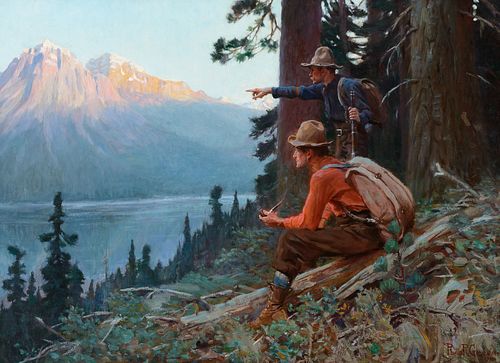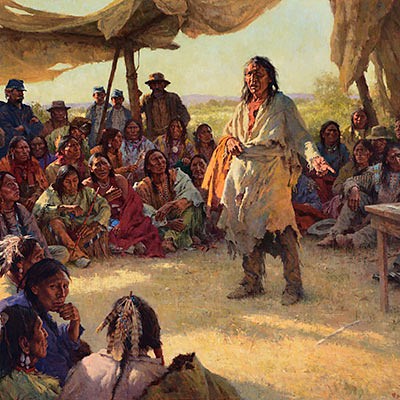Philip R. Goodwin (1881 – 1935) — Blazing the Trail (1911)
About Seller
11944 North Tracey Road
Hayden, ID 83835
United States
Coeur d’Alene Art Auction specializes in the finest classical Western and American Art representing past masters and outstanding contemporary artists. The auction principals have over 100 years of combined experience in selling fine art and have netted their clients over $325 million in the last fif...Read more
Two ways to bid:
- Leave a max absentee bid and the platform will bid on your behalf up to your maximum bid during the live auction.
- Bid live during the auction and your bids will be submitted real-time to the auctioneer.
Bid Increments
| Price | Bid Increment |
|---|---|
| $0 | $100 |
| $2,000 | $250 |
| $5,000 | $500 |
| $10,000 | $1,000 |
| $20,000 | $2,500 |
| $50,000 | $5,000 |
| $100,000 | $10,000 |
| $200,000 | $25,000 |
| $500,000 | $50,000 |
| $1,000,000 | $100,000 |
About Auction
Jul 15, 2023
The 2023 Coeur d’Alene Art Auction, to be held July 15 in Reno, Nevada, will feature 324 selections of unparalleled quality in Western & American Art from historical and contemporary artists such as Maynard Dixon, Howard Terpning, W. Herbert Dunton, Joseph H. Sharp, Charles M. Russell, and more. Coeur d'Alene Art Auction info@cdaartauction.com
- Lot Description
Philip R. Goodwin (1881 – 1935)
Blazing the Trail (1911)
oil on canvas
24 × 33 inches
signed and dated lower right
VERSO
Label, J. N. Bartfield Galleries, New York, New York
Blazing the Trail will be featured in an upcoming book by Tom Petrie titled Following Russell Trails.
According to Goodwin biographer Dr. Larry Len Peterson, “While some may view this masterwork as two mountaineers enjoying the spectacular views of the Rockies, Goodwin created it to honor Charles M. Russell. In Goodwin’s mind, this oil was friendship in solid form. In 1907 and 1910 Goodwin visited Russell at his summer retreat, Bull Head Lodge on stunning Lake MacDonald in Glacier National Park. It was mountain perfection as grand as the Alps. High on the side of a mountain, their breath tasted of diamonds, and they smelled eternity in Glacier country. The paradise called ‘The Crown of the Continent’ was a magnet to the two Titans of Western American art.
“To say that the Russells were in awe of Goodwin would be an understatement. Russell, the student, learned much from his academically trained friend. In that period Russell produced many of his finest paintings. For example – 1907: Sun Worship in Montana, The Truce (perhaps his greatest watercolor), Jerked Down, and Utica; 1908: A Disputed Trail (very Goodwin-esque), Bronc to Breakfast, First Wagon Trail, Land of the Kootenai, York, Smoke of a .45, The Range Mother, The Piegans, and The Medicine Man; 1909: In Without Knocking, The Cinch Ring, Wounded, When Horseflesh Comes High, and The Wagon Boss; and 1910: The Bell Mare, The Sun Worshippers, and Trouble Hunters.
“It’s obvious that Goodwin was as good a mentor to Charlie as Howard Pyle, the father of American illustration, had been to him. This body of work defined Russell as a master artist. It prepared Nancy and him for their first national exhibition ‘The West That Has Passed’ in New York in 1911. He subsequently built on this foundation the rest of his life. As legendary Western art historian Peter Hassrick wrote, ‘Of the dozens of artist cronies he palled around with at this time, none was more devoted and engaging than a painter eighteen years his junior, Philip R. Goodwin…. And finally, in 1914, Russell gathered all of Goodwin’s earlier lessons together and added his genius to produce his masterpiece When the Land Belonged to God.’
“Both Charlie and Nancy enjoyed Goodwin’s visits immensely. Nancy fixed a critical eye on all of Charlie’s friends and tried to distance him from many – especially his old cronies and other artists. Yet, Goodwin was special. As an astute businesswoman, she realized her husband benefited greatly from the talented, young New Yorker. Nancy understood that Charlie was now acquiring all the necessary tools to become a great artist. In the future, all he had to do was revisit Goodwin’s teachings, refine, and get the work out – something Nancy made sure he did.
“Goodwin also benefitted. He along with Nancy took a number of photographs of their time together. Goodwin completed many field sketches that were most valuable to capture the colors of Glacier National Park, but they also provided the backdrops for many of his paintings. Any Goodwin painting with mountains honored his time with the Russells. He stated it was the ‘treat of his lifetime’ and regarding Russell, ‘the man is more than a genius. His work is a great asset to the country and a monument to the Old West.’
“But it wasn’t all work. In 1907 Goodwin added his mark to Bull Head Lodge lore when Russell invited him to help decorate the new fireplace. Apparently, a mason working on the wet fireplace quit for the day, leaving the cement still wet. Both artists succumbed to temptation and etched twelve figures into its face. Today, the fireplace still stands, and the images of a standing moose, wolf, bear, and a cruiser portaging, completed by Goodwin and signed P. R. G., remain.
“By the time Goodwin returned in 1910, he had illustrated African Game Trails (1909) by the most famous and popular man in the world, Theodore Roosevelt who called on the best wildlife artist in America. With completion of his illustrations for Roosevelt’s book, Goodwin was paid $800 and feeling flush, looked forward to his summer trip. Once again, Russell convinced him to visit Bull Head Lodge. While rain had interfered with his 1907 visit, it was the lack of it that made his month-long visit less than ideal. Forest fires were ever threatening, but that didn’t hinder them from hiking the mountains, which generated masterworks such as Blazing the Trail. In 1910 Glacier National Park was dedicated and a grand friendship was cemented.”
PROVENANCE
Manley-McLennan Agency, 1911
Private collection, by descent, donated to
Church of the Holy Cross, Belmont, California, 1949
Coeur d’Alene Art Auction, Reno, Nevada, 2002
Private collection, Colorado
LITERATURE
Larry Len Peterson, Philip R. Goodwin: America’s Sporting & Wildlife Artist, Coeur d’Alene Art Auction and Settlers West Galleries, 2001, p. 135, illustrated
Joan Carpenter Troccoli, ed., The Masterworks of Charles M. Russell: A Retrospective of Paintings and Sculptures, University of Oklahoma Press, 2009, p. 28, illustrated
Joan Carpenter Troccoli, ed., Charles M. Russell: The Women in His Life and Art, C. M. Russell Museum, 2018, p. 87, illustrated
View More InformationCondition
Surface is in excellent condition. Canvas is lined. Hairline cracks and specks of inpainting in sky. Specks of inpainting under the hat brim of the man in the red shirt.
- Buyer's Premium



 EUR
EUR CAD
CAD AUD
AUD GBP
GBP MXN
MXN HKD
HKD CNY
CNY MYR
MYR SEK
SEK SGD
SGD CHF
CHF THB
THB













